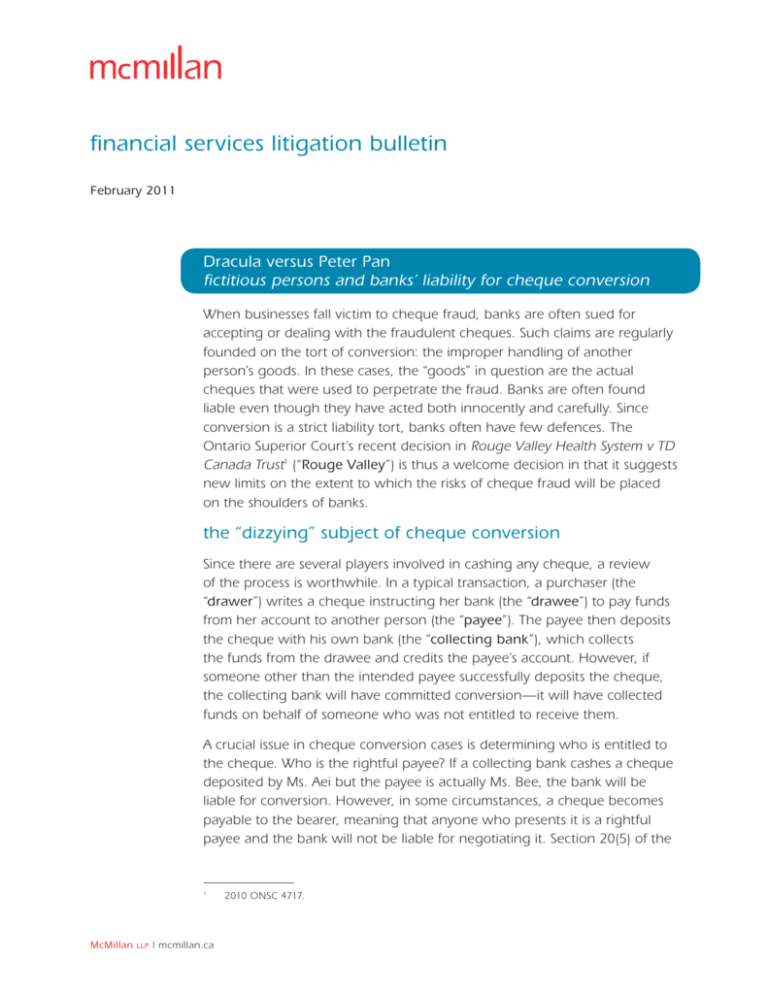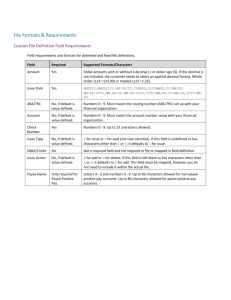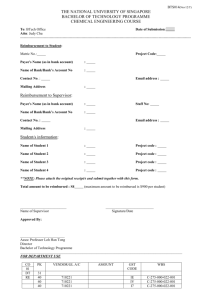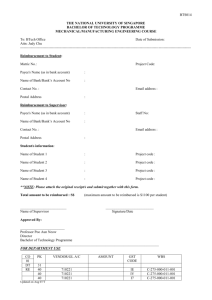Financial Services Litigation Bulletin
advertisement

financial services litigation bulletin February 2011 Dracula versus Peter Pan fictitious persons and banks’ liability for cheque conversion When businesses fall victim to cheque fraud, banks are often sued for accepting or dealing with the fraudulent cheques. Such claims are regularly founded on the tort of conversion: the improper handling of another person’s goods. In these cases, the “goods” in question are the actual cheques that were used to perpetrate the fraud. Banks are often found liable even though they have acted both innocently and carefully. Since conversion is a strict liability tort, banks often have few defences. The Ontario Superior Court’s recent decision in Rouge Valley Health System v TD Canada Trust1 (“Rouge Valley”) is thus a welcome decision in that it suggests new limits on the extent to which the risks of cheque fraud will be placed on the shoulders of banks. the “dizzying” subject of cheque conversion Since there are several players involved in cashing any cheque, a review of the process is worthwhile. In a typical transaction, a purchaser (the “drawer”) writes a cheque instructing her bank (the “drawee”) to pay funds from her account to another person (the “payee”). The payee then deposits the cheque with his own bank (the “collecting bank”), which collects the funds from the drawee and credits the payee’s account. However, if someone other than the intended payee successfully deposits the cheque, the collecting bank will have committed conversion—it will have collected funds on behalf of someone who was not entitled to receive them. A crucial issue in cheque conversion cases is determining who is entitled to the cheque. Who is the rightful payee? If a collecting bank cashes a cheque deposited by Ms. Aei but the payee is actually Ms. Bee, the bank will be liable for conversion. However, in some circumstances, a cheque becomes payable to the bearer, meaning that anyone who presents it is a rightful payee and the bank will not be liable for negotiating it. Section 20(5) of the 1 McMillan LLP | mcmillan.ca 2010 ONSC 4717. financial services litigation bulletin Bills of Exchange Act 2 specifies circumstances when a cheque may become payable to the bearer. In particular, a cheque may be treated as payable to the bearer when the payee named on it is a “fictitious or non-existing person”. So, when is a payee is fictitious or non-existing? Multiple courts have tackled the issue, sometimes with seemingly contradictory results. As noted by the court in Rouge Valley, the following tests, formulated by noted banking law author JD Falconbridge, have been endorsed by the Supreme Court of Canada:3 • Non-existent: If the payee is not the name of any real person known to the drawer, but is merely a creature of the imagination, the payee is non-existing . . . . • Fictitious: If the payee is the name of a real person known to the drawer, but the drawer names him as payee by way of pretence, not intending that he should receive payment, the payee is fictitious, but is not non-existing. [Emphasis added] In Rouge Valley, Justice Grace understandably called this entire subject “somewhat dizzying.” Some courts applying the Falconbridge tests have been reluctant to rule that a payee is non-existing or fictitious. As a result, it has often been difficult for banks to escape liability. Rouge Valley: a novel approach to fictitious persons Rouge Valley involved an ongoing cheque fraud scheme by an employee of the Rouge Valley Health System (the “Hospital”) named Uwe Marshner. Mr. Marshner was not an officer or director of the Hospital, but he did have significant authority, including oversight of a $10 million budget and the power to approve payment of invoices up to $10,000. In coordination with an external accomplice (the “Accomplice”), he arranged for bills to be sent to the Hospital for work that was never actually done, from a service provider that did not actually exist. Mr. Marshner would approve payment of the invoices and the Hospital would issue cheques which were signed mechanically. The Accomplice would then receive the cheques and deposit them into the account held at TD Canada Trust (the “Bank”) by a sole proprietorship which bore a similar name to the ostensible service provider.4 Most of the money was eventually paid back to Mr. Marshner. Between 2003 and 2007, Mr. Marshner approved 78 fraudulent cheques, totalling $686,611. McMillan 2 RSC 1985, c B-4. 3 Boma Manufacturing Ltd v Canadian Imperial Bank of Commerce, [1996] 3 SCR 727. 4 The fraud was originally carried out via cheques payable to a real service provider in respect of services that were never delivered. The fraudsters then changed tactics, preparing invoices from a wholly imaginary company called “Scarborough-York Mobile Rehabilitation”, also in respect of imaginary transactions. The cheques were made payable to “S.M.R.”, but deposited into the account of “SMR and Associates”. LLP | mcmillan.ca 2 financial services litigation bulletin Justice Grace first considered whether the payee was non-existing. The Hospital argued that that the cheques were issued in respect of what it believed to be legitimate transactions to a real service provider. Therefore, it contended that the cheques were not payable to the bearer and the Bank had committed conversion by cashing them on behalf of the Accomplice. In previous decisions, courts had given life to apparently non-existing payees in situations where the drawer was found to have been “reasonably mistaken” as to the identity of the proper payee.5 Justice Grace distinguished Rouge Valley from those previous decisions, holding that in other cases, there had been some pre-existing relationship which could have reasonably led the drawer to believe that the cheque was appropriately delivered to the payee. In this case, minimal due diligence by the Hospital could have uncovered the fact that no legitimate transactions had ever taken place—there was no real relationship between it and the supposed service provider. The payee was found to be non-existent and the Bank was not liable for cashing the cheques. The Court also assessed whether the payee was fictitious. A key issue in this analysis is who the drawer intended to be the payee. In the case of a corporate drawer, this inquiry involves an assessment of the corporation’s directing mind. In Rouge Valley, no one at the Hospital other than Mr. Marshner had turned his or her mind to the cheques, with the perverse result of making the fraudster the drawer’s directing mind in respect of the fraudulent cheques. Since Mr. Marshner intended to pay the funds to his own shell company, the payee would not be fictitious, and the collecting bank would be liable. Refusing to accept this outcome, Justice Grace held that, since the transactions were entirely fraudulent and conferred no benefit on the Hospital, Mr. Marshner had ceased to be a directing mind in respect of the transactions. Consequently, the Hospital did not intend to pay anyone at all, meaning that the cheques were essentially forgeries. As a result, the payee was fictitious and the bank was not liable for negotiating the cheques. lessons for banks and business Despite the ruling in Rouge Valley, banks continue to bear significant potential liability for cheque fraud, no matter how prudent and cautious they are. For instance, Justice Grace may have ruled in favour of the Hospital if the cheques had been payable to an actual or former supplier. Similarly, the risk posed by a fraudster who forges an endorsement may still fall on a collecting bank. Banks should continue to reduce these risks through the diligent review of payee names and endorsements. 5 McMillan LLP For example, an otherwise imaginary payee named “J. Lam” was found to exist because the drawer had previously done business with a supplier named “Van Sang Lam”, but had forgotten the supplier’s name ( Boma, supra note 3). | mcmillan.ca 3 financial services litigation bulletin However, the decision marks somewhat of a departure from previous decisions, in which it sometimes appeared that courts strained to animate what were clearly nonexistent and fictitious payees. As a result, businesses should recognize that, going forward, courts may be less willing to transfer the risk of employee fraud onto banks. If an employee is given such free rein that he or she can approve payments in respect of entirely fictitious transactions with suppliers who have no actual relationship with the enterprise, the court may find that the risk of fraud rests with the employer—not with the collecting bank. by Lisa Brost and Rob Barrass For more information on this topic, please contact: Toronto Toronto Lisa Brost Rob Barrass 416.865.7186 416.865.7099 lisa.brost@mcmillan.ca rob.barrass@mcmillan.ca a cautionary note The foregoing provides only an overview and does not constitute legal advice. Readers are cautioned against making any decisions based on this material alone. Rather, specific legal advice should be obtained. © McMillan LLP 2011 McMillan LLP | Vancouver | Calgary | Toronto | Ottawa | Montréal | Hong Kong | mcmillan.ca




